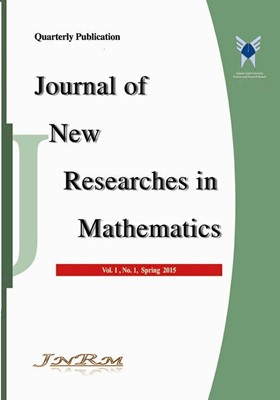مدل لگ نمایی-وایبل معکوس برای سیستمهای منسجم با مولفههای پواسنلیندلی بریده شده در صفر
الموضوعات :مرتضی قاسمی چراتی 1 , عزت اله بالوئی جامخانه 2 , عین اله دیری 3
1 - گروه آمار، واحد قائمشهر، دانشگاه آزاد اسلامی، قائمشهر، ایران
2 - گروه آمار، واحد قائمشهر، دانشگاه آزاد اسلامی، قائمشهر، ایران
3 - گروه آمار، واحد قائمشهر، دانشگاه آزاد اسلامی، قائمشهر، ایران
الکلمات المفتاحية: r-von-Mises minimum distance, Log Exponential-inverse Weibull, Parallel structure, Zero-truncated, Cramé,
ملخص المقالة :
در این مقاله، دو توزیع جدید، برای یک سیستم منسجم که مجهز به اجزای سری یا موازی است را یشنهاد مینماییم. تعداد مولفههای سیستم را متغیر تصادفی پواسنلیندلی بریدهشده در صفر در نظر میگیریم. توزیع لگ نمایی-وایبل معکوس را در نظر گرفته و آن را به عنوان توزیع پایه سیستم منسجم قرار میدهیم. علاوه بر معرفی دو توزیع منعطف به نامهای PL-LEIW1 و PL-LEIW2 با تابع شکست با شکلهای مختلف، ویژگیهای آماری و مبحث برآوردهای پارامتری و ناپارامتری به طور جامع مورد مطالعه قرار گرفته است. با توجه به تنوع رفتاری در تابع چگالی احتمال و توابع خرابی، این دو توزیع مبتنی بر سیستمهای سری یا موازی، میتوانند برای انواع مختلفی از دادهها برازش داده شوند. روشهای برآورد مختلف پارامترها مانند براورد ماکزیمم درستنمایی، براورد حداکثر فاصله حاصلضربی، براورد حداقل مربعات و براورد حداقل فاصله کرامر-ون-میسز از طریق روشهای شبیهسازی مونت کارلو مقایسه میشوند و همچنین کاربرد توزیعهای پیشنهادی با استفاده از دو مجموعه داده واقعی ارزیابی شده است.
[1] C. Kuş, “A new lifetime distribution,” Computational Statistics and Data Analysis, vol. 51, pp. 4497–4509, 2017.
[2] V.G. Cancho, F. Louzada-Neto and G.D.C. Barriga, “The Poisson-exponential lifetime distribution,” Computational Statistics and Data Analysis, vol.55, no. 1, pp. 677–686, 2011.
[3] M. Goldoust, S. Rezaei, Y. Si and S. Nadarajah, “A lifetime distribution motivated by parallel and series structures,” Communications in Statistics-Theory and Methods, vol. 47, no. 13, pp. 3052–3072, 2018.
[4] Y. Sun., T. Sun, M.G. Pecht and C. Yu, “Computing lifetime distributions and reliability for systems with outsourced components: A case study,” IEEE Access, vol. 6, pp. 31359–31366, 2018.
[5] A.F. Hashem and S.A. Alyami, “Inference on a New Lifetime Distribution under Progressive Type II Censoring for a Parallel-Series Structure,” Complexity, vol. 11, pp. 1–18, https://doi.org/10.1155/2021/6684918, 2021.
[6] C. Li and X. Li, “Preservation of increasing convex/concave order under the formation of parallel/series system of dependent components, ” Metrika, vol. 81, no. 4, pp. 445–464, 2018.
[7] L. Xie, M.A. Lundteigen and Y. Liu, “Reliability and barrier assessment of series and parallel systems subject to cascading failures,” Proceedings of the Institution of Mechanical Engineers, Part O: Journal of Risk and Reliability, vol. 234, no. 3, pp. 455–469, 2020.
[8] A.L. Morais. and S.L.P. Ferrari, “A class of regression models for parallel and series systems with a random number of components,” Statistics, vol. 51, no. 2, pp. 294–313, 2017.
[9] L. Zhang and R. Yan, “Stochastic comparisons of series and parallel systems with dependent and heterogeneous Topp-Leone generated components,” AIMS Mathematics, vol. 6, no. 3, pp. 2031–2047, 2021.
[10] P.E. Oguntunde, A. Mundher, M.A. Khaleel, M.T. Ahmed and H.I. Okagbue, “The Gompertz Frأ©chet distribution: Properties and applications,” Cogent Mathematics and Statistics, vol. 6, no. 1, pp. 1–12, 2019.
[11] Z. Ahmad, “A new generalized class of distributions: properties and estimation based on type-I censored samples,” Annals of Data Science, vol. 7, no. 2, pp. 243–256, 2020.
[12] F. Jamal, M.A. Nasir, G. Ozel, M. Elgarhy and N. Mamode Khan, “Generalized inverted Kumaraswamy generated family of distributions: theory and applications,” Journal of Applied Statistics, vol. 46, no. 16, pp. 2927–2944, 2019.
[13] H. Pourreza, E. Baloui Jamkhaneh and E. Deiri, “A family of Gamma generated distributions: Statistical properties and applications,” Statistical Methods in Medical Research, vol. 30. no. 8, pp. 1850-1873, 2021.
[14] R. Tahmasbi and S. Rezaei, “A two-parameter lifetime distribution with decreasing failure rate,” Computational Statistics and Data Analysis, vol. 52, pp. 3889–3901, 2008.
[15] M. Aslam, C. Ley, Z. Hussain, S.F. Shah and Z. Asghar, “A new generator for proposing flexible lifetime distributions and its properties,” PLOS ONE, vol. 15, no.4, e0231908, 2020.
[16] E. Mahmoudi, A. Sepahdar and A.J. Lemonte, “Exponentiated Weibull-logarithmic distribution: Model, properties and applications,” arXiv:1402.2564v1, 2014.
[17] R.A. Khan and M. Mitra, “Estimation issues in the Exponential-Logarithmic model under hybrid censoring,” Statistical Papers, 10.1007/s00362-019-01100-3, 2019.
[18] M. Sankaran, “The discrete Poisson-Lindley distribution,” Biometrics, vol. 26, pp. 145–149, 1970.
[19] M.E. Ghitany, D.K. Al-Mutairi and S. Nadarajah, “Zero-truncated Poisson-Lindley distribution and its application,” Mathematics and Computers in Simulation, vol. 79, no. 3, pp., 279–287, 2008.
[20] J.J. Swain, S. Venkatraman and J.R. Wilson, “Least-squares estimation of distribution functions in johnson’s translation system,” Journal of Statistical Computation and Simulation, vol. 29, no. 4, pp. 271–297, 1988.
[21] T. Duchesne, J. Rioux and A. Luong, “Minimum cramér-von mises distance methods for complete and grouped data” Communications in Statistics-Theory and Methods, vol. 26, no. 2, pp., 401–420, 1997.
[22] R.C.H. Cheng and N.A.K. Amin, “Maximum Product-of-Spacings Estimation with Applications to the Lognormal Distribution,” [Technical report]. Cardiff, UK: Department of Mathematics, University of Wales, 1997.
[23] R.C.H. Cheng and N.A.K. Amin, “Estimating parameters in continuous univariate distributions with a shifted origin,” Journal of the Royal Statistical Society: Series B, vol. 3, pp. 394–403, 1983.
[24] E.T. Lee and J.W. Wang, “Statistical Methods for Survival Data Analysis,” Wiley, New York, 2003.
[25] H. Linhart and W. Zucchini, “Model Selection,” John Wiley, New York, USA, 1986.


